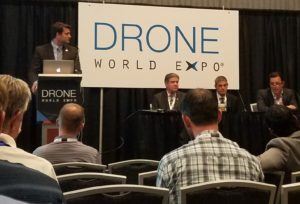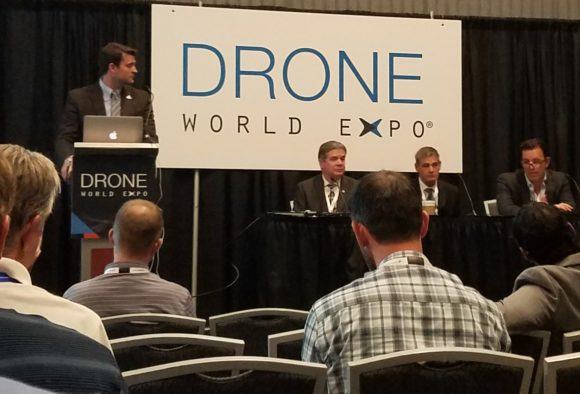Drones may already be impacting the world of workers’ compensation.
Fewer workers on communications towers are falling to their deaths, according to Todd Schlekeway, executive director of the National Association of Tower Erectors.
Schlekeway, who was speaking at a panel on Tuesday at the Drone World Expo in San Jose, Calif., which runs through Thursday, was citing an OSHA study of 135 deaths on communications towers recorded since 2003.
Schlekeway was moderating a panel to talk about how drones, or unmanned aerial systems, are transforming the communications industry, along with Thomas Camp, in business and product development with Verizon’s innovation program, Christopher Moccia, executive vice president of telecommunications for Measure, and Art Pregler, UAS program director for AT&T.

The OSHA study shows that after a spike in deaths in 2013 and 2014, when a massive amount of communication tower building took place to keep up with an explosion in cellular demand, the number of deaths have been falling.
There were four deaths in 2015, seven deaths in 2016 and two deaths so far this year, although the year isn’t over and there were some recent deaths that have yet to be reported, according to Schlekeway.
He noted that there are now 1.2 smartphone devices per person in the U.S., and there are more than 308,000 cell sites and towers. With demand continuing for more towers, and maintenance required of all of those towers, Schlekeway and his fellow panelists said drones are increasingly important in helping to keep workers safer.
Drones are being used often to check out towers for natural hazards like bee hives and raptor nests, to look for infrastructure defects that could injure or kill someone ascending a tower, and to determine what tools will be needed when workers get to their destination high in the air to save trips up, the panelists said.
Rules and Regulations
Despite some consensus followed by some decision making from Congress and the FAA on drone regulations over the past few years, just who is calling the shots when it comes to making drone laws and regulations is far from decided.
It was a difficult question members of one panel tried to tackle, including Charles Raley, unmanned aircraft systems team lead for enforcement, policy and outreach for Federal Aviation Administration.
He and fellow panelists attempted to give a picture of the state of laws and regulations concerning drones, which are being hammered out from federal down to local levels.
“The current state is there’s a lot of tension in this area, and there’s a lack of clarity as well,” Raley said. “Unfortunately, there’s not exactly a clear answer as to who controls what.”
Speaking for the FAA and what it controls, he offered that “we think it’s a lot.”
He said many laws already on the books of state and local governments, such as nuisance ordinances and laws governing acts of voyeurism, that will cover most issues that are being created by drone operators.
Drone Insurance
The lone insurance presence with a booth at the expo was BWI Aviation Insurance, a Corona, Calif.-based broker specializing in drone and other aerospace coverage.
Wesley Ellish, who was working the booth with a few fellow brokers, said they decided to take a spot at the expo in hopes of selling polices and educating drone users on the need for insurance.
“It kind of seems like insurance is on the backburner for some of these guys,” Ellish said.
She said that while several attendees who stopped at the booth felt insurance was the last of their worries, they were able to give dozens of quotes for basic liability policies to offer drone operators coverage.
Quotes were given to a mix of operators, ranging from startup companies to companies that were already considered mid-sized with growing fleets of drones, but by far the class of business that showed the biggest interest in buying drone insurance were instructors, she said.
“I’ve noticed we’ve had quite a few instructors coming up,” she said.
She said they were interested in a training policy that covers the drone and property damage incurred while they or their students were operating the drone.
Panels on Wednesday include “Drones in the Insurance Industry,” “Follow the Money: Exploring the Drone Investment Climate,” and “Drone Response to Hurricanes Harvey and Irma.”
Was this article valuable?
Here are more articles you may enjoy.



 Wildfires, Storms Fuel 2025 Insured Losses of $108 Billion: Munich Re Report
Wildfires, Storms Fuel 2025 Insured Losses of $108 Billion: Munich Re Report  10 Highest Class-Action Settlements in 2025 Eclipsed $70B Total: Duane Morris
10 Highest Class-Action Settlements in 2025 Eclipsed $70B Total: Duane Morris  Experian: AI Agents Could Overtake Human Error as Major Cause of Data Breaches
Experian: AI Agents Could Overtake Human Error as Major Cause of Data Breaches  New York Governor Hochul Vows to Tackle Insurance Affordability, Litigation and Fraud
New York Governor Hochul Vows to Tackle Insurance Affordability, Litigation and Fraud 

